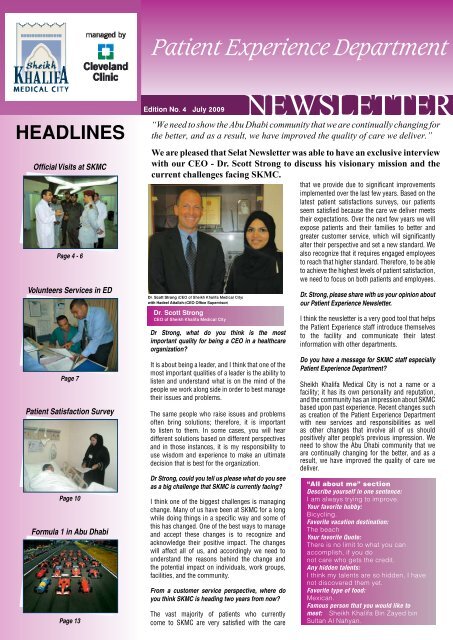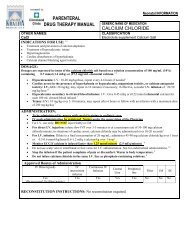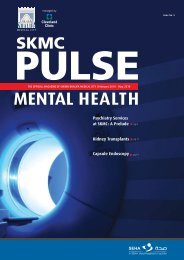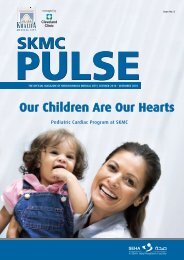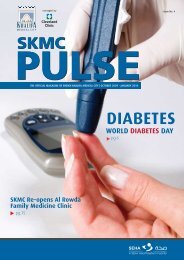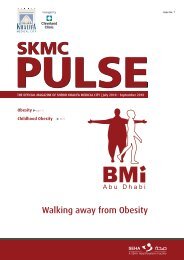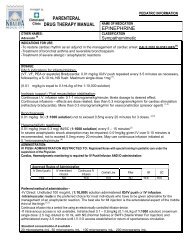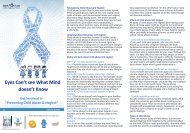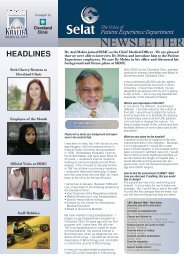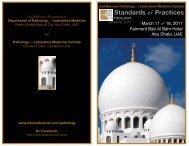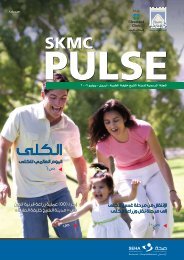Patient Experience Department - Sheikh Khalifa Medical City
Patient Experience Department - Sheikh Khalifa Medical City
Patient Experience Department - Sheikh Khalifa Medical City
- No tags were found...
Create successful ePaper yourself
Turn your PDF publications into a flip-book with our unique Google optimized e-Paper software.
<strong>Patient</strong> <strong>Experience</strong> <strong>Department</strong>Official Visits at SKMCPage 4 - 6Volunteers Services in EDPage 7<strong>Patient</strong> Satisfaction SurveyPage 10Formula 1 in Abu DhabiPage 13Edition No. 4 July 2009“We need to show the Abu Dhabi community that we are continually changing forthe better, and as a result, we have improved the quality of care we deliver.”We are pleased that Selat Newsletter was able to have an exclusive interviewwith our CEO - Dr. Scott Strong to discuss his visionary mission and thecurrent challenges facing SKMC.Dr. Scott Strong (CEO of <strong>Sheikh</strong> <strong>Khalifa</strong> <strong>Medical</strong> <strong>City</strong>)with Hadeel Attallah-(CEO Office Supervisor)Dr. Scott StrongCEO of <strong>Sheikh</strong> <strong>Khalifa</strong> <strong>Medical</strong> <strong>City</strong>Dr Strong, what do you think is the mostimportant quality for being a CEO in a healthcareorganization?It is about being a leader, and I think that one of themost important qualities of a leader is the ability tolisten and understand what is on the mind of thepeople we work along side in order to best managetheir issues and problems.The same people who raise issues and problemsoften bring solutions; therefore, it is importantto listen to them. In some cases, you will heardifferent solutions based on different perspectivesand in those instances, it is my responsibility touse wisdom and experience to make an ultimatedecision that is best for the organization.Dr Strong, could you tell us please what do you seeas a big challenge that SKMC is currently facing?I think one of the biggest challenges is managingchange. Many of us have been at SKMC for a longwhile doing things in a specific way and some ofthis has changed. One of the best ways to manageand accept these changes is to recognize andacknowledge their positive impact. The changeswill affect all of us, and accordingly we need tounderstand the reasons behind the change andthe potential impact on individuals, work groups,facilities, and the community.From a customer service perspective, where doyou think SKMC is heading two years from now?The vast majority of patients who currentlycome to SKMC are very satisfied with the carethat we provide due to significant improvementsimplemented over the last few years. Based on thelatest patient satisfactions surveys, our patientsseem satisfied because the care we deliver meetstheir expectations. Over the next few years we willexpose patients and their families to better andgreater customer service, which will significantlyalter their perspective and set a new standard. Wealso recognize that it requires engaged employeesto reach that higher standard. Therefore, to be ableto achieve the highest levels of patient satisfaction,we need to focus on both patients and employees.Dr. Strong, please share with us your opinion aboutour <strong>Patient</strong> <strong>Experience</strong> Newsletter.I think the newsletter is a very good tool that helpsthe <strong>Patient</strong> <strong>Experience</strong> staff introduce themselvesto the facility and communicate their latestinformation with other departments.Do you have a message for SKMC staff especially<strong>Patient</strong> <strong>Experience</strong> <strong>Department</strong>?<strong>Sheikh</strong> <strong>Khalifa</strong> <strong>Medical</strong> <strong>City</strong> is not a name or afacility; it has its own personality and reputation,and the community has an impression about SKMCbased upon past experience. Recent changes suchas creation of the <strong>Patient</strong> <strong>Experience</strong> <strong>Department</strong>with new services and responsibilities as wellas other changes that involve all of us shouldpositively alter people’s previous impression. Weneed to show the Abu Dhabi community that weare continually changing for the better, and as aresult, we have improved the quality of care wedeliver.“All about me” sectionDescribe yourself in one sentence:I am always trying to improve.Your favorite hobby:Bicycling.Favorite vacation destination:The beachYour favorite Quote:There is no limit to what you canaccomplish, if you donot care who gets the credit.Any hidden talents:I think my talents are so hidden, I havenot discovered them yet.Favorite type of food:Mexican.Famous person that you would like tomeet: <strong>Sheikh</strong> <strong>Khalifa</strong> Bin Zayed binSultan Al Nahyan.
Interview with Mr. IBRAHIM AL KUWAITIDirector of <strong>Patient</strong> <strong>Experience</strong> <strong>Department</strong>2Mr. Ibrahim, would you kindly tell usmore about your background, educationand work experience?After completing my high school fromAl Ain, I went to the United States tocontinue my education in San Diego,California in a college called GrossmontCollege for two years. After gettingthe AS diploma I transferred to LongBeach – California State University andgraduated in Business Managementspecialized in Management InformationSystem.With regards to my career here at SKMC,I started in <strong>Patient</strong> Affairs <strong>Department</strong>where I worked as a <strong>Patient</strong> AffairsOfficer and <strong>Patient</strong> Affairs ComplainOfficer. I Took the role of Deputy Directorof OPSC and Primary Healthcare Clinicsin 2005. In 2006, I worked as a ProjectDirector of Abu Dhabi RehabilitationCenter. Recently, I was named Directorof <strong>Patient</strong> <strong>Experience</strong> under themanagement of the COO, Linda Clark.Mr. Ibrahim, since this is a newdepartment, kindly share with us moreabout the department role mission andvision.The main focus of the <strong>Patient</strong> <strong>Experience</strong><strong>Department</strong> is our patients; therefore weare aiming to create a seamless patientexperience so that we can contributeto the wellbeing of our patient andtheir families. This will help us achieveSKMC mission and enhance the hospitalreputation in the area. With the input ofour department staff, we will create ournew mission and we will share this withour leaders and staff.To achieve our goals, we formed anexecutive committee to oversee fourareas through sub committees. The firstarea is called “The voice of the patient”which includes gathering informationfrom our patients and then analyzingtheir feedback. The second area isthe experience improvement; whichwill look into improving the hospitalenvironment and facilities, helping usto creat a comfortable atmosphere forour patients and their families whilethey are receiving treatment at SKMC.The third area of our focus is experiencesolution. We will be looking intoenhancing the service in SKMCin cordination with other departmentsfor example: waiting time, key word ata key time.A positive change will be seen onthe <strong>Patient</strong> Affairs Officers who willbe taking the role of <strong>Patient</strong> ServiceNavigators with a wide range ofresponsibilities that includes facilitatingcommunication between patients,families and the medical team andensure that all patients concerns andtheir suggestions are consideredMr. Ibrahim, can you tell us about yourrecent visit to Cleveland Clinic in theUSA?My visit to Cleveland Clinic startedwith a hospital tour, which gave me anopportunity to meet with the <strong>Patient</strong><strong>Experience</strong> team. I have also learnedthat our department faces similarchallenges, regardless of the culture,tradition and religion, human natureis the same and that there are lot ofsimilarities when it comes to patientcomplains.The visit was a great experience andit gave me an opportunity to gainknowledge of future challenges that wemight face and at the same time whatare some of the solutions we mightadapt considering the culture andenvironment.As a UAE national in a leadershipposition at SKMC, what advise wouldyou give to our employees?From my perspective, the future ofhealthcare in UAE relies on the handsof those who are currently workingin the hospital, regardless of theirposition.<strong>Patient</strong>s are one of our familymembers, or friends. I encourage allhealthcare providers here to believe inthat. We also have great resources hereat SKMC, as some employees havebeen employed for many years as wellas experts from different backgrounds.It’s a great opportunity to learn fromtheir knowledge and informationbrought to us from different countries.This knowledge can be modified to theculture of UAE citizens. Even Islamencouraged us to seek knowledge and ifwe do a job, we have to do it perfectly.Can you please tell us who Ibrahimoutside SKMC is?I am a family oriented person; I like tospend my time with my family. I alsohave interest in reading and listeningto audio books. One of my favoritewriters is Stephen King and my favoriteaudiobook narrator is Frank Muller.
<strong>Patient</strong> Service Navigators (PSN)WHAT IS PATIENT SERVICENAVIGATORS?Your <strong>Patient</strong> Service Navigator (PSN)is wide-ranging and are responsiblefor facilitating communication betweenpatients, families and the medicalteam; answering patients’ questions;alleviating anxiety over treatments orprocedures; and more. PSNs rounddaily, visiting patients and respondingto concerns that arise. The PSNs havethe ability to solve the problem at amoment’s notice and communicateeffectively and compassionately withpatients of all backgrounds and needs.They are dedicated to the emotional andphysical comfort of our patients, whileskillfully addressing issues before theyescalate into problems.WHY ARE THE PATIENT SERVICENAVIGATORS TALKING TO MYPATIENTS?One of the main goals of your PSN isto speak with as many patients in yourarea as possible. As you can imagine,the spectrum of thoughts going throughyour patients’ mind are various. YourPSN will make a conscious effort toidentify what is important to yourpatient and their resolvation/ triageto those issues. Some of the patientsissues that arise are visiting time,appointment time, ideal care, nursingcare, neighbor issues, environmental,interpersonal complaints, and parking.WHAT IS MY PATIENTS FEEDBACKABOUT THE SERVICE THEY HAVERECEIVED?Just ask!! All the PSNs will share alltheir conversations notes with you,including all the issues that yourpatients have mentioned.WHAT HAPPENS WHEN THERE IS ACONCERN RAISED REGARDING THEPATIENT’S STAY/ CARE?Although we strive to provide ourpatients with world class service everyday, unfortunately, not everyone leavescompletely happy. The PSN is not ina position to make judgments aboutcare. They will act as an outlet for yourpatient to “let loose” any issues thathave been on their mind. The complaintand compliment service encourages allSKMC staff, including PSN to initiallytry to address a patient’s concern atpoint of service.WHAT ARE SOME SITUATIONS THAT ISHOULD INVOLVE THE PATIENT SERVICENAVIGATORS?1. Your patient seems anxious, angryor has unrealised expectations of theservice.2. A patient’s family seems angry orfrustrated.3. A “high maintenance” patient isgreatly affecting the service you provideto your other patients.4. When other staff members alert youto issues that occurred on the previousshift.5. An incident occurred in the ward andyou would like your PSN to documentall the relevant data and opinions.Congratulations to..Ms. Laheeb Tawfieq on her new role as Senior - VIPCoordinator .3
Abu Dhabi Police and Traffic <strong>Department</strong> Visited<strong>Patient</strong>s in the Rehabilitation ward - B4The police officer offering gifts to patientsIn line with Abu dhabi Police celebrations on the occasion of the 24 th Gulf Traffic Week, the Traffic <strong>Department</strong> employeesvisited some of the traffic accidents patients at SKMC. The visitors brought with them gifts for patients and wished themfast recovery.National Health Insurance visit – DAMANMs. Gabriela with the Daman VisitorsOn 25 March 2009, team members of the National Health Insurance- Daman. visited a number of patients at SKMC. The visitstarted by patients in the Surgical Wards and continued to the <strong>Medical</strong> ones. The Daman representatives presented beautifulflower arrangements to patients, bringing a smile on everybody’s face.4We would like to take this opportunity to thank the Daman Insurance visitors for their visit and to SKMC patients for theirkind cooperation.
Etihad Airways Social Responsibility Group put asmile on the faces of children at <strong>Sheikh</strong> <strong>Khalifa</strong> <strong>Medical</strong> <strong>City</strong>In another effort to give back to the community, the Etihad Airways Social Responsibility Group visited SKMC on May7, 2009 and spent wonderful time with special needs kids at the hospital as well as other children admitted for variousillnesses.Ms. Gabriela Hirculescu and Ms. Nasma Al Ameri from the Volunteer Services accompanied the Etihad visitors in a touraround the pediatric wards at SKMC and oriented them about the different sections and services provided by the hospital.At the Abu Dhabi Rehabilitation Center (ADRC), the group members were welcomed by the Social Workers in ADRC andwere also oriented about the center and patients.We would like to thank the Etihad Airways Social Responsibility Group for their kind visit and gifts that they brought withthem for our patients.The Etihad Airways Social Responsibility Groupvisiting pediatric wardsThe Etihad Airways Social Responsibility Groupat the main entrance of ADRCZADCO employees visit to ADRCZADCO, CAMS program graduates in ADGM UZFD Group have visited the Abu Dhabi Rehabilitation Center (ADRC) on 28April 2009.The visit was very successful and the team met the patients in the Geriatric, Old Age and Children Wards at the center. Theytalked to the patients and socialized with them. We would like to send out our sincere appriciation to the group of ZADCO.6CAMS Graduates visit to Abu DhabiRehabilitation Center
Meet our Senior VolunteersName : Shivam Kumar “Shivu ”Age : 16School : International School of Choueifat“I really enjoyed volunteering last year and Icame back this year because I like to helppatients”.Name : HarishAge : 16School : International School of Choueifat“ When I help patients, I am touched by theirsmiles and gratitude. This gives meunsurpassable pleasure; thus, returning toSKMC to volunteer was irresistible.Name : Immanuel NixonAge : 16School : International School of Choueifat“Volunteering at SKMC had taught me manythings in my life. Working with patients inneed and helping the community has alwaysbeen my passion”.Name : Ebram TardosAge : 19School : Waterloo University“My first year volunteering at SKMC was a blastand I learned lots of things and hope this yearwill be as beneficial and rewarding”.Name : Hazem ShoblakAge : 19School : University of Alberta – Edmonton– Canada“I enjoyed working with other volunteers andstaff and providing assistance to patientsand families. I am back at SKMC to relive thememories of last year”.Name : Sophia WastiAge : 18“I came back volunteering because I wantedto do something positive this summer and Ilike my previous experience. It took me out ofmy comfort zone and requires me to deal withunique situations”.ER VolunteersThe Volunteer Services is pleased to announce the launching of“ED Volunteers”. The volunteers started helping in theEmergency <strong>Department</strong> (ED) since the 1 st of June 2009. Theywork on shifts; some come mornings while others participate inthe evening. The program’s main mission is to escort patientsupon their arrival, as well as entertaining children at the waitingarea. We would like to take this opportunity to thank the voluntteersand the ED staff for their continued help and support inorder to improve the quality of healthcare at SKMC.Omar El Kawkgi working withShaaban Ali - Unit Clerk translator7
VOLUNTEERS AT SVolunteers recognition for International ChildhoodCancer Day (ICCD)26 February 2009Traditional UAE Dance (YOLA) for patients inWard B4Hemophilia Day Celebration16 April 2009Volunteers serving refreshments tothe patientsInternational Thalassemia Day21 May 2009Musical Day for patientsin Ward B48International Thalassemia Day21 May 2009International Thalassemia Day21 May 2009
KMC ACTIVITIESHemophilia Day16 April 2009Music and the Brain Concert in SKMCfor <strong>Patient</strong>s25 March 2009Volunteers helping during Lab Week24 - 28 May 2009Arts and crafts activity for patients inWard B4Volunteers helping duringAmbulatory DayMusic and the Brain Concert in SKMCfor <strong>Patient</strong>s25 March 2009Volunteers helping duringAmbulatory Day9
<strong>Patient</strong> Satisfaction SurveyThe <strong>Patient</strong> <strong>Experience</strong> <strong>Department</strong> was selected by the Quality Management <strong>Department</strong> to do a pilot study for the <strong>Patient</strong>Satisfaction Survey for inpatients. The <strong>Patient</strong> Service Navigators (PSNs) in the Surgical and <strong>Medical</strong> Pavilions were responssiblefor distributing the surveys among the patients who where ready to be discharged from the hospital.Every month, the <strong>Patient</strong> Service Navigators had to submit approximately 400 questionairs in total. They did an excellent jobas they did not only reach the benchmark, but they exceeded it. On the other hand, the last report provided by the QualityManagement <strong>Department</strong> showed that the Urgent Care Center PSNs have exceeded all the expectations by getting more than700 questionaires filled in May.Nahed Al Marar - <strong>Patient</strong> Service Navigator conducting asurvey with a patientCounseling TrendsMariam Al Muraikhi shares with us her knowledge and experience during her attendance to the Counseling Arabia Conference2009 which was held in Abu Dhabi Women College between April 7 th – 9th 2009.Counseling Arabia Conference is an annual event that has been actively running in order to develop the professionalismof counseling field both in the UAE and the Gulf region. This year the conference took place in the capital of the UAE,Abu Dhabi. The theme of this year’s conference was “Transitions: Evolutions of Client and Practitioner”. The conferencemembers came from a wide variety of roles including students and professionals in counselling, career development,human resources, academic advising, social work and special needs practitioners. The first two days of the conferenceconsisted of workshops and presentations about the theme. The final day comprised of training programs relevant forprofessionals across the field.10
COMFORT Your serviceThe delivery of the service must be on time, accurate, withconcern, and with courtesy. One may ask why these elementsare important? The answer is that all their services areintangible and in function of perception. As such, they dependon interpretation. In addition, and perhaps more important,service by definition is perishable and if left unattended, itcan affect on the organization.COMFORT is caring, observant, mindful, friendly, obliging,responsible, and tactful.These characteristics are the most basic attributes ofcustomer service and without them; there cannot be a trueservice of any kind. They all depend on interpersonal skills,communication, empowerment, knowledge, sensitivity,understanding, and some kind of external behavior.For example, caring will show that, indeed, you are interestedin what the customer will have to say. You may spend timewith a customer to find out the customer’s real needs, wants,and expectations.You must be observant. In most cases observations maycontribute more to satisfying the customer than directcommunication. Paying attention to body language andmannerisms and, if necessary, read between the lines.Always try to be a step ahead of the customer. Anticipate thecustomer’s action. Actively listen for what the customer iscommunicating, but also—and, perhaps, more importantly—listen for which reason the customer is not communicating.You must be mindful. Remember that you and yourorganization exist to satisfy the customer. Withoutthe customer’s need, you do not have a job and theorganization does not have a service to provide. Thecustomer has a choice and, as such, if you or theorganization does not recognize the urgency, sensitivity,uniqueness, expectations, and influence that thecustomer has, you will not be successful in satisfyingthe customer.You must be friendly. Friendliness does not meanbeing a pest. Offer guidance and information, and letthe customer know you are there to help. If necessary,provide feedback to assist the customer in making adecision. If you do provide a feedback, be truthful.You must be obliging. Patience is the key word tocustomer satisfaction. Sometimes customers do notknow what they want. They are making up their mindsas they go along. As such, accommodating themmay make the difference between a satisfied and anunsatisfied customer. When obliging the customer, donot hesitate to educate the customer as well.You must be responsible. You are the expert. Thecustomer is looking for you to provide the appropriateinformation in a clear, concise, and easy to understandmanner. What you are trying to accomplish is to developa relationship where your expertise can indeed help thecustomer.You must be tactful. In any service organization, andin any service delivery, may accur problems betweenyou and the customer. Do not panic. Tactfulness is theprocess by which the conflict may be resolved. Yourfocus is to satisfy the customer and, as such you shouldtry to identify the problem, analyze it, and then solve itin the most expedient way.References• Customer Service and Satisfaction• R. Fleiss, “Here Is the Scoop on Ben and Jerry’s,”Office Systems 89, February• 1989, pp. 15–18; S. Hutchens, “What Customers Want: Results of ASQC/• Gallup Survey, Quality Progress, February 1989, pp. 29–35.• P.D. Feldman, “I Searched for Excellence and Finally Found It in a Cab,”• Marketing News, August 19, 1991, p. 9.• D.H. Stamatis, Total Quality Service, Delray Beach, FL: St. Lucie Press, 1996.11
Word SearchLook for each word listed on the right in the mix of letters. Circle the words you find.Be the first to submit your word search to Gabriela Hirculescu in Volunteers Services and win a prize!Email: ghirculescu@skmc.gov.aePromotionFormulaThalassemiaHemophiliaRecognitionPioneersInternational patient careMothers dayEtihadChristopher ColumbusMansafWINNER for the last word search is:We would like to thank Le MeridienHotel AbuDhabi for the lunch voucher provided to the winner .Bincymol Kuriakose- Nurse- Clinic 812Recipe of the MonthIngredients1 whole chicken, cut into serving pieces1 1/2 quarts plain yogurt1 egg1 cup almonds, freshly toasted1/2 cup pine nuts, freshly toastedto taste, parsley, finely choppedto taste, saltto taste, pepper6 servings long grain white rice(like basmati)Serves / Yields4 - 6 ServingsCHICKEN MANSAFPreparation InstructionsPlace chicken in large pot with enough salted water to barely cover it.Cook over medium heat until almost done, about 3/4 hour.In a separate pan, cook enough rice for 6 large servings.In a large saucepan, stir yogurt until it is quite smooth.Add beaten egg and heat over medium heat, stirring constantly.Add enough of the liquid from the cooked chicken to make a thin sauce,about the consistency of very heavy cream.Heat until it almost comes to a boil and thickens slightly.Add the cooked chicken pieces to the yogurt sauce and finish cookingthe chicken in the sauce, at a low temperature.On a large platter, mound the rice in the center.Arrange the chicken pieces on the rice and pour most of the yogurtsauce over it, reserving the remaining sauce to be added, as desired,by the diners.Garnish with the almonds, pine nuts and parsley around the edges ofthe mound of rice and chicken.Serve warm accompanied by warmed pita bread.
All you need to know about Formula 1Formula 1 is the highest class of auto racing. It’s official name is FIA formula world championship also the F1 seasons it’sknown as Grands Prix. The F1 is the largest annual sporting event. Plus it has more than 200 broadcasters worldwide, inmore than 188 countries and it has an annual cumulative audience of 2.73 billion viewers. More than 400 permanent F1 presscorps represents all principal global media groups, agencies, magazines and websites. It’s a global showcase for major carmanufactures: Toyota, Renault, Mercedes Benz, Ferrari, and BMW.There are many rules & regulations in Formula 1 race. Some of them are as follows:Engines:Drivers will be limited to 8 engines per season if they exceed it,they will face a penalty.Testing:The testing for the car is not allowed during the race season.Aerodynamics:This rule is the biggest area of change for 2009. The body of thecars should follow certain rules related to reducing downforce;it’s the pressure created by the aerodynamic characteristics of acar that allows going faster through the corner by increasing thepressure.Scoring:For the driver to earn points, he isn’t required to finish the race but at least 90% of the winners race distance must be comppleted.The following table show how much points each position has:F1 in Abu Dhabi1st place2nd place3rd place4th place5th place6th place7th place8th place10 points8 points6 points5 points4 points3 points2 points1 pointNext F1 Grand Prix will be held in Yas Marine Circuit, in Abu Dhabi and it’s located near Abu Dhabi International Airport. Theseason will start in November 2009. It’s the only circuit in the world where there is a 5-star hotel with 500 bedrooms near toit and will have special entrance for the race guests.What people say about this circuit?Former Red Bull driver David Coulthard saw the circuit model atthe Chinese Grand Prix in Shanghai: “Wow!” he said, “I wish Iwasn’t retiring!”The President and CEO of Formula One Group, Bernie Ecclestonesaid: “From the start of this project we were in no doubt that F1in Abu Dhabi would be something different, something special- the original plans have evolved almost beyond recognition, andwe are very pleased with the results.”Refrences:http://www.formula1.com/inside_f1/rules_and_regulations/sporting_regulations/8692/http://en.wikipedia.org/wiki/Formula_Onehttp://www.yasmarinacircuit.ae/en/content/41/abu-dhabi-grand-prix.htmlhttp://en.wikipedia.org/wiki/Downforce13
Trinidad & TobagoLocation: Trinidad and Tobago lay in the Caribbean Sea of the northeast coast of Venezuela.Population: 1,300,000 inhabitantsLanguages: English(official), Hindi, French, Spanish and ChineseEthnicity/ Race: Indian 40%, African 37.5%, Mixed 20.5%, Other 1.2% and 0.8% unspecified.Religions: Roman Catholic 26%, Anglican 8%, Baptist 7%, Pentecostal 7%, Seventh- Day Adventist 4%, Other Christian 6% Hindu,Islam 6% and 2% declared as non Religious.Monetary Unit: Trinidad and Tobago Dollar.Trinidad and Tobago are generally considered as part of the West Indies by virtue of its geographical and historical heritage in theCaribbean. Unlike most of the English-speaking Caribbean, Trinidad and Tobago’s economy is primarily industrial-based, with an emphasison petroleum and petrochemicals. It is the wealthiest independent Caribbean country, boasting a high standard of living and high literacyrates. Although Tobago is often referred to as «the jewel of the Caribbean» and contains a number of resort areas, Trinidad and Tobagoas a whole does not heavily rely on tourism as a source of revenue although the climate is tropical. There are two seasons annually: thedry season for the first six months of the year, and the wet season during the second half of the year.Trinidad and Tobago are one of the most prosperous and stable democratic nations in the Caribbean with 1.3 million inhabitants. Twomajor ethnic groups - Afro-Trinidadians and Indo-Trinidadians - account for almost 80% of the population, while people of mixed-race,European, Chinese and Syrian-Lebanese descents present most of the rest of the population.14
HistoryA visit to Trinidad today would reveal a multicultural melting pot stirred by the descendantsof settlers from Europe, Africa, Asia, South America and the Middle East. But in 1498, whenexplorer Christopher Columbus set foot on Trinidad, things were very different.Arawak and Carib Indians prospered here on an island the Amerindians called Ieri, land ofthe Humming Bird, until Columbus spotted the island he named for the Holy Trinity. Whenthe Spaniards discovered no precious metals on Trinidad, the Amerindians were enslavedand shipped off to work on other Caribbean settlements.Trinidad remained under the control of Spain till the end of the 18th century. It was takenover by the British in 1797 and was converted into a British colony at the beginning of the19th century. Since then, it was the British influence that controlled the administration andthe economy of Trinidad.Tobago, unlike Trinidad, was controlled by the French, the Dutch, Spaniards and the Englishat different period of times. Tobago changed European hands for 22 times before beingfinally over by Great Britain in 1814. Trinidad and Tobago got incorporated into a single colony in 1888.However in 1962, Trinidad and Tobago gained complete independence and became a member of the British Commonwealth . In 1976,this was declared as republic with an elected president to head an independent government.CuisineThe Cuisine of Trinidad and Tobago indicates a mix of Amerindian, European, African, Creole, Indian, Chinese and Lebanese gastronomicinfluences. The Curry Chicken and Roti is a nationally well-known main cuisine of Trinidad and Tobago. This dish was adopted from EastIndian roots. Another nationally popular cuisine with distinctly African and indigenous roots is Callaloo. As one might expect in an islandnation, seafood dominates Trinidad and Tobago cuisine. Pelau, a rice-based dish, is also a standard dish in Trinidad and Tobago. Otherlocal dishes include coo coo, sancoche, macaroni pie and oil down. Lobster, king fish, crab, and even shark are often on the menu. Youcannot go to Trinidad and Tobago without having a taste of bake and shark with all its condiments. Curried crab and dumplings is a topdish on the island of Tobago. As for coconuts, when it comes to a national drink, one could effectively nominate coconut water.CultureThe Trinidad culture is heavily dominated by native Africans and native Indians. Trinidad and Tobago is famous for its pre-Lenten TrinidadCarnival. It is also the birthplace of calypso music and the steel pan, which is widely claimed to be the only acoustic musical instrumentinvented during the 20th century. The diverse cultural and religious background allows for many festivities and ceremonies throughoutthe year. Other indigenous art forms include soca (a derivate of calypso), chutney, and pichakaree and the famous Limbo dance.Theartistic scene is vibrant. Trinidad and Tobago claims two Nobel Prize-winning cultural authors, V. S. Naipaul and St. Lucian-born DerekWalcott. Mas’ designer Peter Minshall is renowned not only for his Trinidad carnival costumes, but also for his role in openingceremonies. Tobago culture is rich in folklore music and dance inspired by the African heritage of its inhabitants.15
What isHappiness?There are so many ways to define happiness. Hereare some definitions of happiness to inspire you.Finding happiness is like finding yourself. You don’t find happiness, youmake happiness. You choose happiness. Self-actualization is a processof discovering who you are, who you want to be and paving the way tohappiness by doing what brings YOU the most meaning and contentment toyour life over the long run.• True happiness is not attained through self-gratification, but through fidelity to aworthy purpose.• You will never be happier than you expect. To change your happiness,change your expectation.• Hope is itself a species of happiness, and, perhaps, the chief happinesswhich this world affords.• Happiness is man’s greatest aim in life. Tranquility and rationality are thecornerstones of happiness.These definitions of happiness are by Epicurus.Contributors:Abdulla Al Mansoori, Nasma Al Ameri, Omer Suragabi, Mariam Al Meraikhi, Margaret Al Ahmadi,Neama Al Kathairi, Gabriela Hirculescu.


